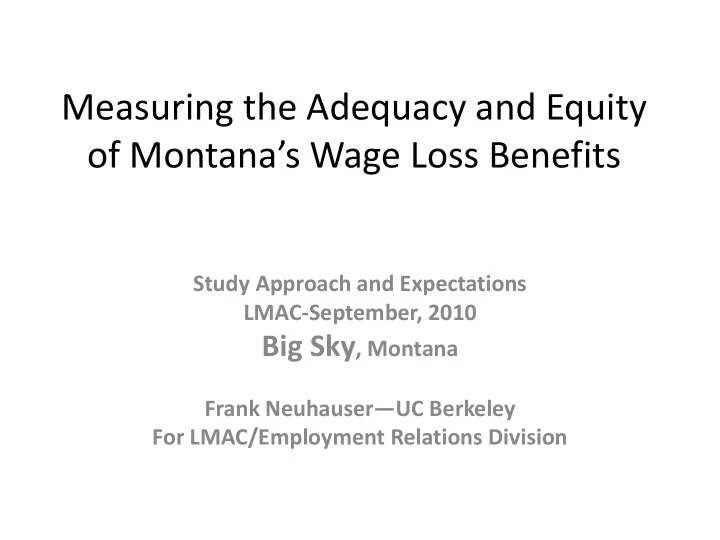

Measuring the Adequacy and Equity of Montana’s Wage Loss Benefits Study Approach and Expectations LMAC-September, 2010 Big Sky , Montana Frank Neuhauser — UC Berkeley For LMAC/Employment Relations Division
Policy Objectives • Adequacy -- Level of benefits – How much of workers’ lost wages are replaced by benefits? • Equity – Distribution of benefits across workers – Horizontal equity — similarly disabled workers get similar benefits – Vertical equity – more seriously disabled workers get higher benefits • Cost — employers and workers are concerned with impact of the cost of workers’ compensation on profits, jobs, and wage levels.
Policy Objectives • Adequacy and equity are usually treated in a vacuum – Level of benefits is known but – Level of losses is unknown – Distribution of losses across workers is unknown So, – Adequacy of wage loss replacement is unknown – Equity across differently affected workers is unknown ERD study will fill in the missing pieces and allow LMAC, EAIC, and ultimately the Legislature to make informed decisions
Estimating Wage Loss • Main challenge — we do not observe the injured workers wages if they had not been injured — need to estimate future wages • Wages at-injury are a poor proxy for future wage path – Age – Unemployment – School-family-children
Estimating Wage Loss Uninjured Injured Wages Time Injury Return to Work
Matching Injured Workers to “Controls” • Identify two groups of workers – Disabling injuries including permanent impairments – Medical-only claims — generally minor injuries with little expected long-term impact on earnings • Medical-only claimants are pool of potential matched controls. We use their wages as a proxy for injured worker wages, in the absence of an injury
Matching Injured Workers to “Controls” • Matching Criteria – Gender – Age – Wage, 4 quarters prior to injury quarter – Employer size – Occupation (class code)
Hypothetical Example 10,000 7,500 Control workers Quarterly earnings, 5,000 $ 2,500 Wage loss Injured workers 0 – 20 – 10 0 10 20 Quarters before and after injury
Hypothetical Example 10,000 Quarterly 7,500 Control workers earnings and WC 5,000 benefits, Uncompensated 2,500 Injured wage loss workers Benefits 0 – 20 – 10 0 10 20 Quarters before and after injury
Proportional Wage Loss, Replacement Rate wages Benefits $120,000 3year post injury earnings $100,000 uncompen wage sated $80,000 loss $60,000 Benefits $40,000 $20,000 $0 Control Injured
Measures • Wage Loss Control Earnings – Injured Worker Earnings • Proportional wage loss (Wage Loss)/(Control Earnings) • Replacement Rate — after tax (Benefits)/(Wage Loss*(1-tax rate))
ERD Study • 17,000 Permanent Disability Claims • 230,000 Medical-Only Claims • Injury dates: 1999-2007 • UI Earnings data 1997-2009
ERD Study • For each PD claim – Define impairment rating percent – Split claims into 5 groups based on impairment • 1% - 2% • 3% - 5% • 6% - 10% • 11% - 15% • 16%+ – Estimate wage loss for each group
Wages of Sample Groups relative to Quarter Prior to Injury --FY1999 to FY2007 120% 100% % of Q-1 80% 60% IR: 0.01-2.99 IR:3-5.99 IR:6-10.99 40% IR:11-15.99 IR:16+ MO 20% 0% Q_10 Q_9 Q_8 Q_7 Q_6 Q_5 Q_4 Q_3 Q_2 Q_1 Q0 Q1 Q2 Q3 Q4 Quarters
Wages of Sample Groups relative to Quarter Prior to Injury 1999-2007 120% 100% % of Q-1 80% 60% 40% IR: 0.01-2.99 IR:3-5.99 IR:6-10.99 20% IR:11-15.99 IR:16+ MO 0% Q_4 Q_3 Q_2 Q_1 Q0 Q1 Q2 Q3 Q4 Q5 Q6 Q7 Q8 Q9 Q10 Q11 Q12 Q13 Q14 Q15 Q16 Q17 Q18 Q19 Q20 Quarter s
Wages of Sample Groups relative to Quarter Prior to Injury 1999-2007 $7,000 Average Quarterly Wage($) $6,000 $5,000 $4,000 $3,000 $2,000 IR: 0.01-2.99 IR:3-5.99 IR:6-10.99 $1,000 IR:11-15.99 IR:16+ MO $0 Q_4 Q_3 Q_2 Q_1 Q0 Q1 Q2 Q3 Q4 Q5 Q6 Q7 Q8 Q9 Q10 Q11 Q12 Q13 Q14 Q15 Q16 Q17 Q18 Q19 Q20 Quarters
Four year post MMI wage loss % wage loss % cases 1% to 2% 21.9% 22.2% 3% to 5% 17.7% 30.7% 6% to 10% 25.6% 27.7% 11% to 15% 34.1% 9.5% 16%+ 48.5% 9.9% All 25.4%
Benefit Adequacy Study--Timetable Over next several weeks • Refine Impairment vs. PPD grouping • Determine wage loss for each group • Determine benefits for each group • Determine “Replacement Rates” for each group Next month, further define matching to measure impact of age, gender, employer size, occupational risk
Recommend
More recommend